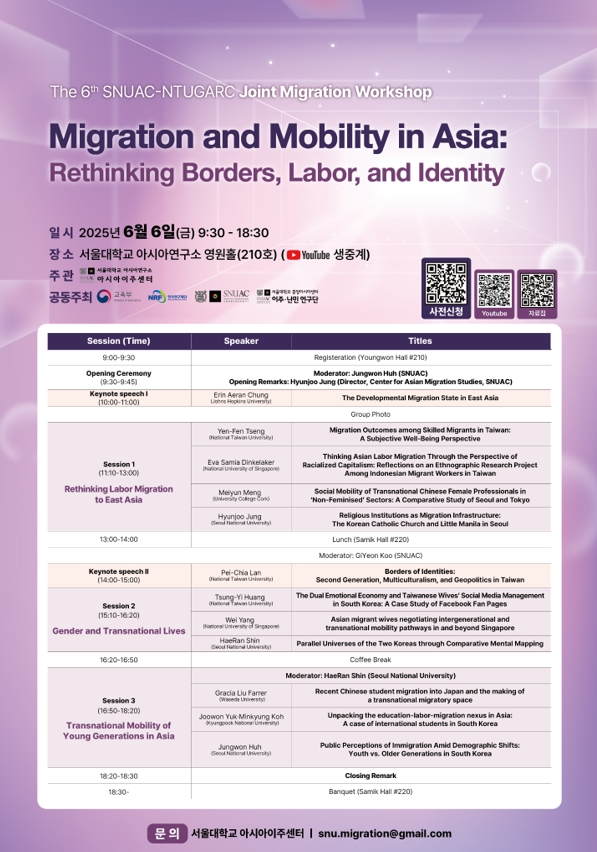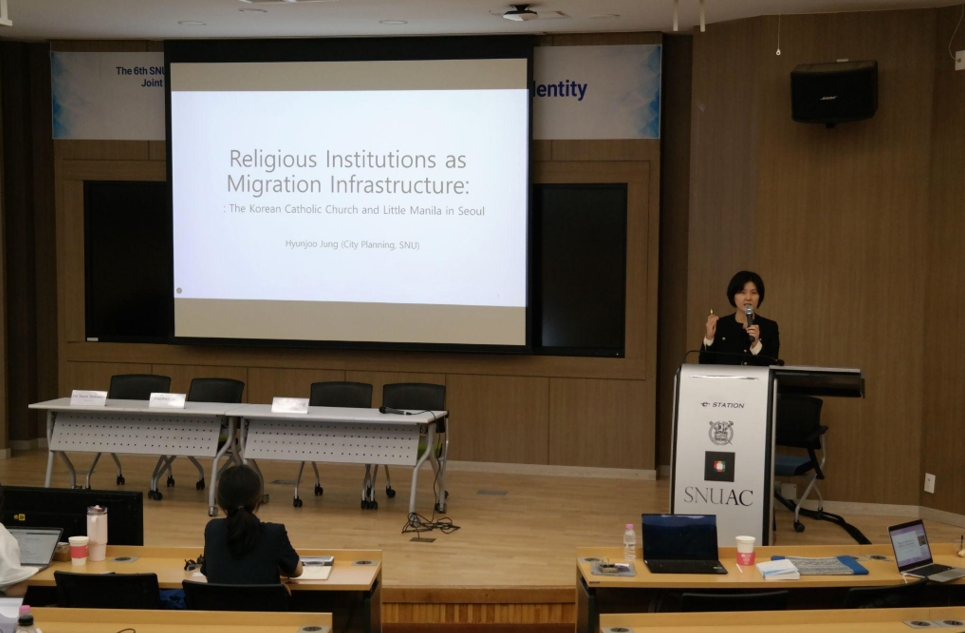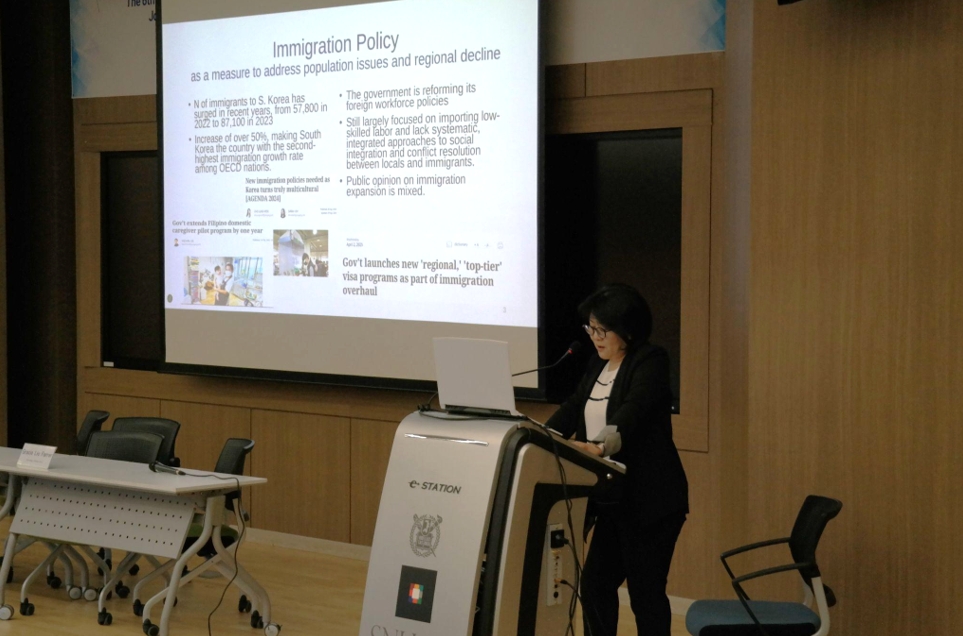On June 6, Seoul National University’s Asia Center (SNUAC) hosted its sixth joint migration workshop to date in collaboration with National Taiwan University’s Global Asia Research Center (NTUGARC). Titled Migration and Mobility in Asia: Rethinking Borders, Labor, and Identity, this year’s workshop featured two keynote addresses by world-renowned scholars in migration studies. The first speaker was Professor Erin Aeran Chung (Johns Hopkins University), known for her influential theory of the “developmental migration state,” and the second was Professor Pei-Chia Lan (National Taiwan University), who has conducted extensive research on the emergence of multiculturalism in the East Asian context. With a diverse group of international scholars presenting their areas of expertise, the event was organized into three sessions: Rethinking Labor Migration to East Asia, Gender and Transnational Lives, and Transnational Mobility of Young Generations in Asia.

Poster for Migration and Mobility in Asia: Rethinking Borders, Labor, and Identity
Professor Jung Hyunjoo (Department of Environmental Planning), the director of the Center for Asia Migration Studies at SNUAC, presented a unique case study on Little Manila, a multicultural migrant space born in the heart of Seoul. Little Manila stands apart from other migrant enclaves in Korea, which are often hidden or on the urban margins. In contrast, this community is embedded within Daehangno, a vibrant cultural district that was once the site of several SNU campuses prior to their relocation in 1975. Following major urban development, the area transformed into a bustling hub of theaters, art institutions, galleries, and street performance venues—shaped for public gatherings and diverse cultural expression. These unique urban conditions, rare in Korea’s broader migrant geographies, enabled Little Manila to take root.
Moreover, unlike most migrant enclaves in Korea—which emerged after the introduction of the Employment Permit System (EPS) in 2004 and are typically multiethnic and state-facilitated—Little Manila predates the EPS and developed organically. Its name reflects its predominantly Filipino composition.
The case study of Little Manila can be examined through incorporating insights from the theoretical frameworks of migration infrastructure and civic legacies. Beyond this, however, Professor Jung seeks to develop a meso-level theoretical framework of her own, which is both localized and hybridized, offering an intermediary lens to understand international migration. Rather than reducing migration outcomes to national migration regimes or global capitalism alone, her approach emphasizes the complex interplay of factors. In this regard, Professor Jung’s research is guided by several key questions: What distinguishes Little Manila from other kinds of migrant spaces typically formed under the EPS? How have religious institutions, particularly the Korean Catholic Church, contributed to the formation and continued vitality of the community? How have local social and spatial conditions, alongside historical contexts, shaped both the past-dependent and emergent dimensions of multicultural space-making in South Korea? In addressing these questions, Professor Jung hopes to contribute to broader discussions defining the Asian model of immigration incorporation and the inter-Asian variations within this model.

Professor Jung Hyunjoo on “Religious Institutions as Migration Infrastructure: The Korean Catholic Church and Little Manila in Seoul”
Professor Huh Jungwon (HK research professor of SNUAC) continued the migration workshop by presenting findings from her research on the “Public Perceptions of Immigration Amid Demographic Shifts: Youth vs Older Generations in South Korea.” In the face of Korea’s deepening demographic crisis and regional decline, immigration policy has emerged as a significant strategy to address these challenges. However, the lack of a systematic and integrated approach to social integration and conflict resolution between Korean locals and immigrant communities remains a major issue. Public attitudes towards immigration expansion differ across generations, underscoring the importance of age-based perspectives in shaping the direction of South Korea’s future immigration policy.
Drawing from the survey results of 1,000 Korean adults, Professor Huh approached her analysis with the following questions: What are Korea’s perceptions regarding the expansion of immigration? What factors influence these perceptions? Do attitudes differ between the younger and older generations? If so, are there differences in the variables that affect these attitudes?
Professor Huh’s results reflect the noticeable shift towards political conservatism among the younger Korean generation. Among those aged twenty and below, support for and opposition to immigration expansion were evenly split, and a clear majority of participants in their thirties opposed expansion. Meanwhile, the gap narrowed drastically among those in their forties, with opposition barely outweighing support. Support was dominant among respondents in their fifties and beyond.
Similar patterns emerged in opinions towards specific immigration-related policies. Those in their twenties and thirties expressed greater skepticism towards state funding for Korean language education targeting foreign immigrants and multicultural education programs. However, there was overall support across all age groups towards extending maximum stay for low-skilled workers with E-9 visas and enhancing multicultural inclusion education in Korea as a whole.
In summation, while the Korean population broadly recognizes the necessity of immigration, the extent of support varies across generations. Professor Huh found that public perception of immigration expansion is significantly influenced by one’s attitude towards migrant workers, marriage migrants, Korean Chinese, Yemeni refugees, and media portrayals of foreign nationals. These influential factors were largely consistent among cohorts over the age of thirty, with the exception of views on the Korean Chinese having minimal impact. The opposite held true for the younger generation, as perceptions are notably shaped by attitudes towards the Korean Chinese and media narratives regarding foreign nationals.

Professor Huh Jungwon on “Public Perceptions of Immigration Amid Demographic Shifts: Youth vs Older Generations in South Korea”
SNUAC hosts a diverse selection of academic conferences, special lectures, seminars, and other workshops all throughout the year. Be sure to tune in to what else the center has to offer.
Written by Lee Hee Seo, SNU English Editor, heeseolee@snu.ac.kr

